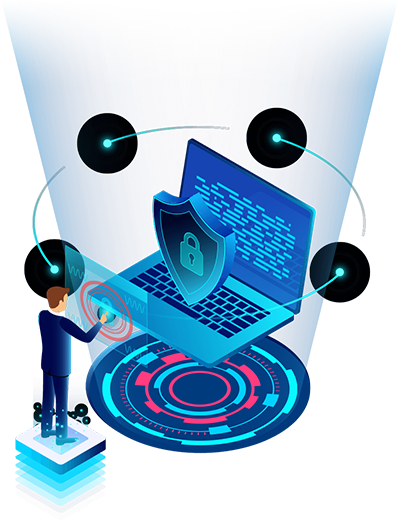Services & Solutions
Expert guide on Cybersecurity
Services We Offer
- Managed Detection & Response (MDR)
- Security Information & Event Management (SIEM)
- User and Entity Behavioral Analytics (UEBA)
- Endpoint Detection & Response (EDR)
- Network Detection & Response (NDR)
- Security Automation, Orchestration & Response (SOAR)
- Security & Compliance Consulting & Product Sourcing
Endpoint Detection & Response (EDR)
Endpoint Detection and Response (EDR) is a cybersecurity solution that provides continuous monitoring and threat detection for endpoints, such as computers, laptops, and mobile devices. It offers a range of features that help organizations detect, respond to, and mitigate cyber threats.

Some key features of EDR include:
- Continuous monitoring: EDR continuously monitors endpoints for malicious activity and suspicious behavior, providing a constantly updated view of potential threats.
- Threat detection: EDR uses a combination of advanced technologies, such as machine learning algorithms and expert analysis, to identify potential threats, such as malware, ransomware, and insider threats. It alerts security teams when a potential threat is detected, enabling them to take action to mitigate the risk.
- Response capabilities: EDR has built-in response capabilities, such as the ability to isolate infected devices or block network communication, to help mitigate the impact of a security incident. It also includes tools for managing the response to a security incident, including incident prioritization, assignment, and resolution.
- Integration with other security solutions: EDR can be integrated with other security solutions, such as firewalls, intrusion prevention systems, and threat intelligence feeds, to provide a comprehensive view of an organization's security posture.
- Customization: EDR can be customized to fit the specific needs and requirements of an organization, including the ability to define custom rules and alert thresholds. This helps ensure that the solution aligns with an organization's existing policies and procedures.

Expert analysis: EDR is provided by a team of experienced cybersecurity professionals who are trained to identify and understand the nuances of cyber threats. They are available to provide expert analysis and support to help organizations respond to and mitigate potential threats.

Overall, EDR is a powerful solution for organizations looking to enhance their security posture with a proactive and comprehensive approach to detecting and responding to potential threats on their endpoints. It combines advanced technology with expert human analysis to help organizations stay ahead of potential threats and protect their systems and data.

What is EDR with MDR? or Managed EDR?
Managed Endpoint Detection and Response (EDR) is a cybersecurity solution that combines EDR with Managed Detection and Response (MDR) capabilities to provide organizations with a comprehensive and proactive approach to security.
EDR is a solution that helps organizations detect and respond to potential threats on their endpoints, such as laptops, tablets, and smartphones. It uses a combination of advanced technologies and expert analysis to identify potential threats, and provides tools and capabilities for responding to and mitigating those threats.
MDR is a cybersecurity solution that combines advanced technology with expert human analysis to detect and respond to cyber threats. It is designed to provide organizations with a comprehensive and proactive approach to security that can help prevent data breaches and other security incidents.
Managed EDR combines the capabilities of EDR and MDR to provide organizations with a comprehensive and proactive approach to security across their entire IT environment, including their endpoints. It continuously monitors networks, endpoints, servers, and applications for malicious activity and suspicious behavior, and provides a constantly updated view of potential threats. It also has built-in response capabilities to help mitigate the impact of a security incident, and provides tools and support for coordinating and managing the response to a security incident.
Overall, Managed EDR is a valuable solution for organizations looking to enhance their security posture with a comprehensive and proactive approach to detecting and responding to potential threats across their entire IT environment. It combines advanced technologies and expert human analysis to help organizations stay ahead of potential threats and protect their systems and data.

What is Difference Between
EDR and XDR? Is there one?
Endpoint Detection and Response (EDR) and Extensive Detection and Response (XDR) are both security technologies that are designed to help organizations detect and respond to potential threats. However, there are some key differences between the two:
- Scope: EDR focuses specifically on detecting and responding to threats at the endpoint level, which refers to devices such as computers, laptops, and mobile phones that are connected to an organization's network. EDR solutions typically use data from the endpoint itself, such as log files, system events, and network traffic, to detect and respond to threats.
XDR, on the other hand, takes a broader, more holistic approach to security, encompassing not just endpoints but also other areas of an organization’s security posture, such as networks, cloud environments, and applications. XDR solutions can use data from a wider range of sources, including endpoints, networks, cloud environments, and applications, to provide a more comprehensive view of an organization’s security posture.
- Capabilities: EDR solutions typically include capabilities such as threat detection, incident response, and remediation support, which can help organizations identify and respond to potential threats at the endpoint level. XDR solutions can also include these capabilities, but may also offer additional features such as analytics, machine learning, and integration with other security tools and systems. This can help organizations get a more complete understanding of their security posture and take a more proactive approach to threat prevention.
Overall, the main difference between EDR and XDR is the scope and comprehensiveness of their approach to security. EDR is more focused on detecting and responding to threats at the endpoint level, while XDR takes a broader, more holistic view of an organization’s security posture. Both technologies can be useful for helping organizations protect against cyber attacks and other security breaches, but the right choice for a particular organization will depend on its specific security needs and priorities.
You Often Hear The Reference Legacy Anti-Virus (AV) vs Next-Gen AV or EDR. What Does This Mean to Me?
Legacy anti-virus (AV) software has been around for decades and was one of the first lines of defense against cyber threats such as viruses and malware. It works by identifying known threats using signature-based detection, which involves comparing the code of a piece of software to a database of known virus definitions. If a match is found, the AV will block the software from running and alert the user.
One of the main limitations of legacy AV is that it can only protect against threats that it has been specifically designed to detect. This means that new, unknown threats may not be detected and blocked. In addition, the AV must be continuously updated with new virus definitions in order to stay effective, which can be time-consuming and resource-intensive.
Next-generation anti-virus (AV) represents a significant evolution in cyber security technology. It uses a behavior-based approach to detecting threats, which involves continuously monitoring the activity of software and blocking any that exhibits suspicious or malicious behavior. This allows next-generation AV to protect against new, unknown threats in addition to known ones.
Next-generation AV also provides a more comprehensive level of protection than legacy AV. In addition to protecting against viruses and malware, it can also protect against ransomware, phishing attacks, and other advanced threats. It may also include additional features such as web filtering, email filtering, and vulnerability assessments.
Endpoint detection and response (EDR) is a proactive approach to cyber security that involves continuously monitoring the activity on a device and alerting the user or administrator if any suspicious activity is detected. This allows the user or administrator to take appropriate action to prevent an attack. EDR can be used in combination with AV to provide an additional layer of protection.
In summary, the main difference between legacy AV and next-generation AV is the approach to detecting and preventing threats. Legacy AV uses signature-based detection to identify known threats, while next-generation AV uses behavior-based detection to identify both known and unknown threats. Next-generation AV also provides a more comprehensive level of protection and may include additional features such as web and email filtering. EDR adds an additional layer of protection by continuously monitoring activity and alerting the user or administrator of any suspicious activity.
Why 360 SOC?
At 360 SOC, we understand that no two organizations have the same security needs and requirements. That’s why we offer both Managed Detection and Response (MDR) and Security Operations Center as a Service (SOC as a Service), tailored to meet your unique security requirements. Our team of experts will work with you to understand your organization’s specific security needs and goals, and design a customized solution that delivers the protection and support you need to stay safe from cyber threats. With 360 SOC, you can feel confident that your organization’s networks and systems are in good hands, and that you have the tools and resources you need to effectively detect and respond to any security incidents.


